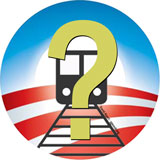Change?
On November 4, I was out in the streets cheering when CNN called the election for Obama. Change was in the air. In a matter of months, a new era would start in America—an era of growing environmental consciousness, of reinvestment in our cities, of policies for the people—instead of for corporate executives.
Now, I am worried. In a speech on Saturday, the President-elect called for investment. But I did not hear a call for anything remotely like the Second System. Instead I heard a call that hearkens back to the Eisenhower Administration:
We will create millions of jobs by making the single largest new investment in our national infrastructure since the creation of the federal highway system in the 1950s. We’ll invest your precious tax dollars in new and smarter ways, and we’ll set a simple rule — use it or lose it. If a state doesn’t act quickly to invest in roads and bridges in their communities, they’ll lose the money.
Granted, Obama did not actually call for investment in the federal highway system. But he did use it as an example. Where are his calls for high speed rail? Where are his examples of the UMTA transit program of the 1970s that gave us BART, Metro, and MARTA? The program that gave us LRT in San Diego, in Pittsburgh, in San Francisco?
In a world where highway building has been the status-quo for over 5 decades, the lack of mention of transit does not bode well. For the last 7 years, Mr. Bush has called for Americans to reduce their dependence on foreign oil in each of his States of the Union. Not once did he ask Americans to try transit—nor did he do much to increase the supply of transit. Do we face another 4 years of the same?
Mr. Obama says that if communities don’t invest in roads and bridges, they’ll lose federal dollars. I fear that if they don’t invest in transit, they’ll lose their communities. But where are Mr. Obama’s pledges of money to fund transit projects that are in design?
According to yesterday’s Washington Post, Maryland and Virginia have new hopes for road projects canceled by the recent downturn. Excuse me? What about the major cuts to MARC service proposed by MTA? Shouldn’t we be hoping for a stimulus that would at least keep transit service at today’s levels, especially in the face of vast increases in ridership?
On Monday, the Post ran a story about transit ridership across the nation—it’s up, way up. In heavy rail, LA leads the pack with a 14.1% increase over last year. Baltimore’s light rail leads with an increase of 19.6%. The Railrunner in Albuquerque leads with a huge increase of 35.8%. For the Post’s editorial board, the evidence is clear and convincing. They’re calling for investment in transit. The Post rightly points out that any fast-acting stimulus penalizes transit because of the hoops we’ve created for those projects to jump through. And while Obama might be the likeliest candidate to change that situation, he has so far shown no inclination to fund a transit stimulus.
Even though VMT is dropping and transit ridership is increasing, Mr. Obama wants to give states money to widen highways, like I-66 and I-95, but doesn’t see fit to give a few federal dollars to stop the elimination of already-crowded commuter trains running alongide these corridors.
Indeed, with all this talk of infrastructure spending to rival the New Deal, why haven’t we heard about his pick for Secretary of Transportation? If we’re really going to invest in our transportation infrastructure like Eisenhower did, why isn’t Mary Peters’ replacement already drawing up plans?
I’m still holding out hope for a Transportation Secretary like Jim Oberstar or Earl Blumenauer, but with Obama’s talk of highway spending, I’m afraid we’ll get someone more like Robert Moses.
I haven’t yet given up hope for change. But I also haven’t heard much since November 4 to suggest that change is really coming, at least to transportation policy. And in this time of high ridership and demand for government infrastructure investment, that would be a shame. This is the chance of a generation to change the way our cities are structured—we cannot afford to squander that opportunity just to build more highways. Not if we have any hope for redesigning cities to survive into the 21st century—a century guaranteed not to be the century of cheap oil.
Editor’s note: Transportation For America has an online campaign to contact your Senators and Representatives (especially if you live outside disenfranchised DC) to push them to pass the right stimulus. Please sign it.

